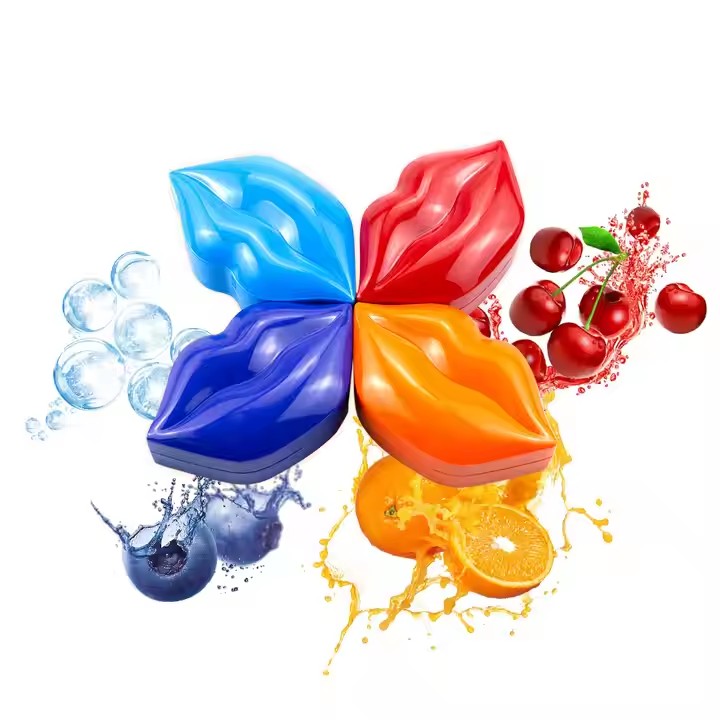What is the difference between lip balm and lip mask?
Although lip balm and lip mask both focus on lip care, they have significant differences in product form, ingredient ratio, efficacy emphasis, application scenarios and frequency. Just like the “daily protective soldiers” and “deep restorers” for dry lips, they each play different care roles.
1. Product form and texture: The difference between portability and weightiness
Lip balm: It is mostly designed in a rotating tube shape, with a texture similar to wax or cream. It is light, thin and easy to spread, making it convenient to carry around and reapply. Its texture is relatively refreshing and can quickly form a thin and transparent moisturizing film on the lips, making it suitable for daily use at any time.
Lip mask: Commonly seen are canned pastes, thick tubular pastes or patch types. They have a heavier texture and are in the form of paste or gel. Some products contain high concentrations of oil components. After application, they will form a distinct closed film layer on the lips, which feels more moisturizing but slightly sticky.
2. Ingredient composition: Emphasis on basic moisturizing and deep repair
Lip balm: The core ingredients are mainly occluding moisturizers such as Vaseline, beeswax, and mineral oil, combined with moisturizing ingredients like vitamin E and glycerin. Some products may add cooling ingredients such as menthol and camphor (which may irritate sensitive lips), or fragrances and pigments to adjust the usage experience. The ingredients are relatively simple and focus on immediate moisturizing.
Lip mask In addition to high-concentration Vaseline, beeswax, and natural oils (such as olive oil and shea butter), it often contains repair components like hyaluronic acid and ceramides, as well as antioxidants (such as vitamin C derivatives) and plant extracts (honey and oat essence), making the composition more complex and focusing on deep nourishment and damage repair. Some products also contain mild exfoliating ingredients (such as natural fruit acids) to improve rough lips.

3. Function Positioning: The difference between immediate hydration and long-term repair
Lip balm: It focuses on “instant moisturizing”, which can quickly relieve the dryness and tightness of the lips. It is suitable for dealing with mild dehydration caused by daily environments (such as air-conditioned rooms and dry weather), or as a primer before makeup to improve lip peeling. However, the moisturizing effect lasts for a relatively short time (usually 2-4 hours), and its effect on improving severe cracking and deep lip lines is limited.
Lip mask: Focusing on “deep repair”, it creates a long-lasting closed moisturizing environment through a thick texture, allowing effective ingredients to penetrate deep into the lip skin and improve problems such as dryness, cracking, peeling, and pigmentation. Long-term use can fade lip lines and brighten lip color. It is especially suitable for concentrated night care or when the lips are in extremely poor condition (such as after extremely dry autumn and winter or intense sun exposure), and the repair effect lasts longer.
4. Usage scenarios and frequency: The difference between daily high-frequency and periodic intensification
Lip balm: It is a “daily essential item” that can be reapplied anytime and anywhere. It is recommended to use it 3 to 5 times a day (such as after drinking water, after meals, and when feeling dry). It is suitable as a portable care for commuting, working, and going out. However, frequent use may cause the lips to become dependent on their own moisturizing ability due to substances such as mineral lipids in its ingredients. It is necessary to pay attention to choosing a mild formula.
Lip mask: It is more suitable for “periodic care”. Generally, it should be used 2 to 3 times a week, or continuously for 3 to 5 days when the lips are in poor condition (such as thick application at night). After applying the patch lip mask for 10 to 15 minutes, wash or wipe off the excess paste. The canned lip mask can be used as a sleeping lip mask overnight to deeply nourish the skin during the golden period of skin repair at night. It is not recommended to use it every day to avoid adding extra burden to the lips.
5. Targeted problem-solving: Stratified care for mild dryness and severe damage
Lip balm: It is suitable for addressing mild lip issues such as slight dryness, early signs of peeling, moisturizing before makeup, or as a basic daily care to prevent dryness. However, it cannot deal with serious problems such as deep cracking, peeling and scabbing.
Lip mask: It is more effective for severe lip problems, such as cracked lips in winter due to freezing, inflammation and peeling caused by frequent licking of the lips, and dark lip lines formed by long-term pigmentation. It repairs the damaged barrier through intensive nourishment and improves the rough texture of the lips.
Post time: Jun-23-2025










